|
|

Handbook on Viewing Buddhist Statues
A totally wonderful
book by Ishii Ayako.
Some images
at this site were
scanned from this
book; Japanese
language only;
192 pages;
80+ color photos
Click here to
buy book at Amazon
Sanskrit Characters
Tobifudo (J-site)
|
|

Tamonten 多聞天
King of the North, Lord Who Hears All
Associations = North, Winter, Earth, Wealth, Black
ORIGIN = Hindu deity incorporated into Buddhism.
Member of the TENBU, SHITENNŌ, JUNITEN, DEVA
One of Four Heavenly Kings Who Guard East, West, North, South
Governed by Taishakuten (Skt. = Indra), Lord of the Center
Manifestation of Kuvera (Hindu God of Wealth & Treasure)
Known as Bishamonten when worshipped independently
|
Japanese Mantra
おん べいしらまなや そわか
On Beishiramanaya Sowaka (or)
Om Beishiramanaya Sowaka
|
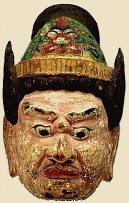
Heian Era Mask of Tamonten
Photo: Kyoto National Museum
|

Sanskrit Seed
for Tamonten
Pronounced
BEI in Japan
|
|
|
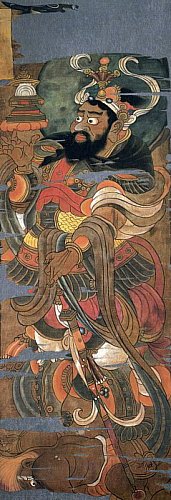
Tamonten (North)
Tang Dynasty, 9th Century
Ink and colors on silk
H = 50.5 cm, W = 17.5 cm
British Museum, Steain Painting 138
Hidden Library Cave, Dunhuang, China.
Scanned from here.
|
|
 TAMONTEN 多聞天. One who is all knowing, one who hears everything in the kingdom, one who is always listening, completely versed in Buddha's teachings. Said to be the most powerful of the four Shitennō, with the other three serving as his vassals. Also the most popular and widely known of the four in Japan. Also said to be the richest of the Shitennō, for Tamonten was rewarded with great wealth after practicing austerities for 1,000 years. Commander of the Yakṣa 夜叉 (who guard the earth's treasures), the the Rākṣasa (monstrous-looking guardian deities), and the Kinnara (celestial musicians with horse heads).
Tamonten protects holy places and places where Buddha expounds the teachings; carries pagoda-shaped treasure house in left hand (from which he gives wealth to only “the worthy;” right hand holds a spear; sometimes shown holding an umbrella, which wards off distractions and contamination. Also called the God of War, often referred to as the Black Warrior (see Genbu-Tortoise entry for more on the Black Warrior), protector of the righteous, and Buddhist patron of warriors. Sometimes shown holding a mongoose to represent his victory over the Nagas. Sometimes known as Kubera (or Kuvera), the “God of Wealth and Buried Treasure, The King of the Yaksa (Yaksha),” and in this manifestation is typically depicted in gold. One source says the Chinese sometimes call Tamonten by the Sanskrit name Dhanada (Bestower), and in China this manifestation is known as Duōwén (Duowen). In this latter manifestation, his associated animal is considered the ermine, or "snow weasel." Tamonten is the Buddhist equivalent to the turtle in Chinese mythology.
In Japanese mandala, says the Great Mandala Study Group: “Tamonten is often depicted as yellow (as bright as 1,000 suns). In his right hand he holds an umbrella (to avoid distractions and contamination); in his left hand, a jewel-spitting mongoose, which can provide sentient beings with inexhaustible wealth. Because his breath is deadly, he always sits with his mouth shut.” (Editor’s note: The color associated with Tamonten varies in the various texts).

|
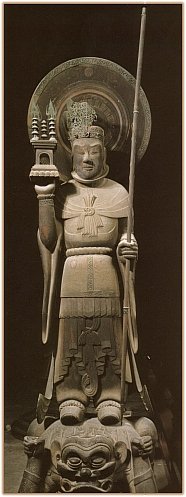
Tamonten atop a Jyaki Demon
7th C., Hōryūji Temple 法隆寺, Nara.
Oldest extant statue of Tamonten.
Photo: Comprehensive Dictionary of Japan's National Treasures.
Published by Kodansha Ltd. 1985
ISBN 4-06-187822-0
|
|
 VARIOUS SPELLINGS & ATTRIBUTES VARIOUS SPELLINGS & ATTRIBUTES
- Japanese = Tamonten 多聞天
- Sanskrit = Vaiśravaṇa, Vaisravana, Vaishravana, Dhanada
- Chinese = Duōwén Tiān, Tuo-wen T'ien
- Korean = 다문천, Damun Cheon, Tamun Ch'ŏn
- Vietnamese = Đa văn thiên
- North, Winter, Earth, Wealth, Black (Yellow in India & China)
- King of the North, hears much, well-versed in Buddha’s teachings
- Dwells in and protects the northern continent Hokkurushū 北倶盧洲 (Skt. = Uttara-kuru) surrounding Mt. Shumisen 須弥山 (Skt. = Mt. Sumeru). This mountain is the mythical home of the Historical Buddha and other Buddhist deities).
- Manifestation of Kuvera (Hindu God of Wealth)
- Most powerful of the four Shitennō
- Known as Bishamonten when worshipped independently. Bishamonten is the scourge of evil doers, the black warrior, and one of Japan’s Seven Lucky Gods.
- Rules over the Yakṣa 夜叉; warriors of fierce stance, powerful earth deities who guard the world's wealth, nature spirits that can be benign or demonic
- Rules over the Rākṣasa; creatures who torture / feed upon the flesh of the dead (of those who were evil while living)
- Rules over the Kinnara (horse-headed celestial musicians)
- Appears in the northen portion of the Gekongōbu-in 外金剛部院. (outer section) of the Taizōkai Mandala 胎蔵界曼荼羅 (Womb World, Matrix Realm).
- Appears in various other mandala, including the Ten Realms Mandala and Hōrōkaku Mandala.
- In the Nichiren sect, Tamonten is #4 on the Gohonzon 御本尊 diagram.
- Nearly always dressed in armor (yoroi 鎧), looking ferocious (funnusō 忿怒相), and carrying weapons or objects (jimotsu 持物) said to eliminate evil influences and suppress the enemies of Buddhism. Also typically shown standing atop evil spirits (known as Jaki in Japan), symbolizing the power to repel and defeat evil. Sometimes depicted with a fiery halo.
- Often depicted holding a stupa or pagoda in right hand and a halberd (hoko 戟 or hōbō 宝棒) in left; the small pagoda symbolizes the divine treasure house, and Tamonten shares the pagoda's vast treasures with only "the worthy." The deity’s attributes, however, are not rigidly prescribed and thus differ among Buddhist nations. Sometimes shown holding a mongoose, representing victory over the Naga (serpentine creatures).
- Oldest extant statue of Tamonten is part of a set of four Shitennō statues possessed by Hōryūji Temple 法隆寺 in Nara that dates to the mid-7th Century. See photo below.

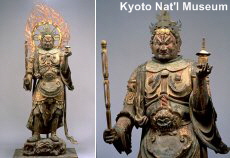
Tamonten, Joruri-ji Temple in Kyoto (click to enlarge)
Color on wood. H=167.0 cm. Late-Heian Period (11th Century). National Treasure.
Photo: Kyoto National Museum
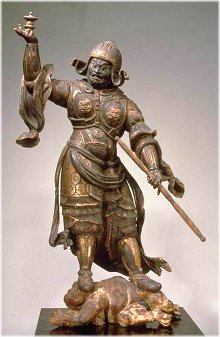
Tamonten (Bishiamonten)
Kamakura Period, 12th-13th Century, Wood, H = 155.5 cm
Photo: Nara National Museum

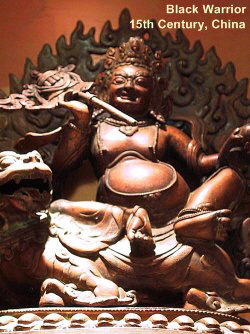  VAISHRAVANA (Skt.) VAISHRAVANA (Skt.)
TAMONTEN (Jp.)
THE BLACK WARRIOR
Below text & photo from: antiquezen.com
Photo: Bronze Vajravana, Northern China, 15th century.
Vaishravana, in China, is the guardian of the North, the most powerful of the four Buddhist kings protecting the four directions of the compass. "He who is all knowing" and "He who hears all in the kingdom." He is often called the "black warrior" because his color is symbolically black and he presides over winter. He is shown here, holding the sacred mongoose. In Japan he is called Tamonten (this page) or Bishamonten, in China Duowen, and the Mongols called him Bisman Tngri. In Tibet he is most often known as Rnam Thos-kyi Bu or Rnam Thos-sras. He is known for his miracles and was worshiped by the hermit Myo-ren in Japan. Although he is a protector from evil, and is often seen trampling demons, here he rides the magical Keilown. In his arm is the magical staff or Trident of Wisdom. (Editor’s Note: The mythical Chinese tortoise is also called the Black Warrior, but turtle imagery in Japan has been mostly merged with and supplanted by its Buddhist counterpart, Tamonten (this page).

|
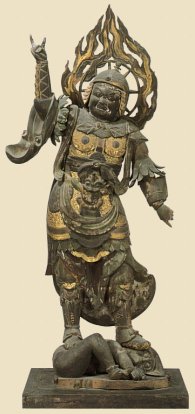
Tamonten, Heian Era, 12th Century
94 cm, Wood with Pigment
Hōryūji Temple 法隆寺, Nara
|
|
 KUBERA / KUVERA (Sanskrit). Hindu God of Wealth. Says Meher McArthur, the curator of East Asian Art at the Pacific Asia Museum (Pasadena): KUBERA / KUVERA (Sanskrit). Hindu God of Wealth. Says Meher McArthur, the curator of East Asian Art at the Pacific Asia Museum (Pasadena):
“In Tibet and Nepal, Vaishravana (Jp. = Tamonten, Bishamonten) is closely related to the God of Wealth, Kubera, who is considered to be his most important manifestation. It is possible that Vaishravana is the Buddhist form of the earlier Hindu deity, Kuvera/Kubera, who was the son of an Indian sage, Vishrava, hence the name, Vaishravana. According to Hindu legend, Kubera performed austerities for a thousand years, and was rewarded for this by the greator god, Brahma, who granted him immortality and the position of God of Wealth, and guardian of the treasures of the earth. As Vaishravana, this deity also commands the army of eight Yasha (Yaksa), or demons, who are believed to be emanations of Vaishravana himself. The most important of these eight are the dark-skinned Kubera of the north and the white Jambala of the east. Each of these emanations holds a mongoose that spews jewels. In Tibet and Nepal, he is worshipped as the God of Wealth in all three manifestations: Vaishravana, Kubera, and Jambala.”
“In many Tibetan and Nepalese images of Kubera, the deity is shown as a plump figure wearing a crown, ribbons and jewelry, and holding a mongoose, representing this god’s vistory over the naga (snake deities), who symbolize greed. As God of Wealth, Vaishravana / Kubera squeezes the mongoose and causes the creature to spew out jewels.” < quoted from Meher McArthur’s book “Reading Buddhist Art: An Illustrated Guide to Buddhist Signs & Symbols.” ISBN 0-500-28428-8, Published 2002 by Thames & Hudson. McArthur is the curator of East Asian Art at the Pacific Asia Museum (Pasadena). Click here to view or buy book at Amazon. >

|
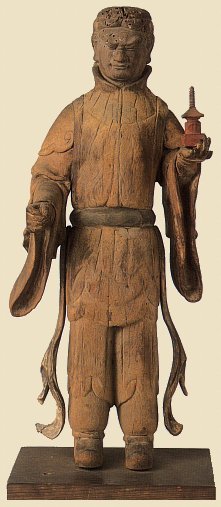
Tamonten, Plain wood, 51.5 cm
Asuka Period, 7th Century, Houryuu-ji Temple
|

Tamonten, 110 cm Wood
Heian Period, 11th Century, Houryuu-ji Temple
|
|
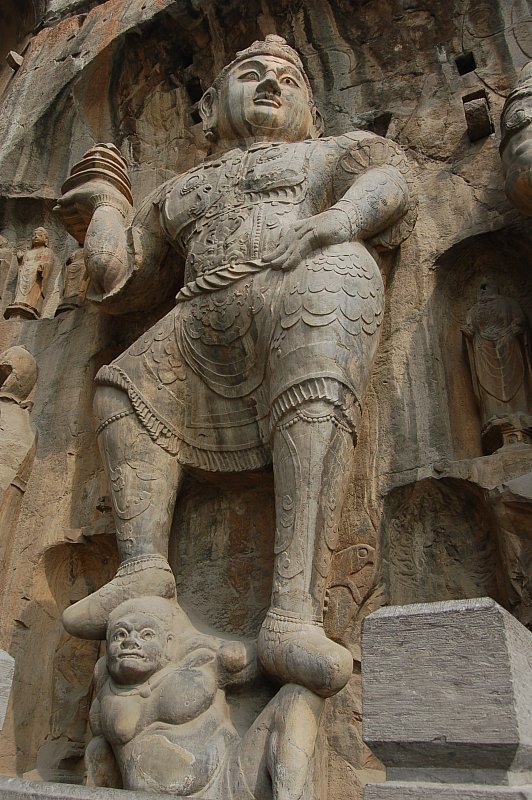
Tamonten (aka Bishamonten). Guardian of the North. Chinese = Duōwén Tiān
Longmen Grottoes, China. Tang Dynasty.
Photo by Mark Schumacher
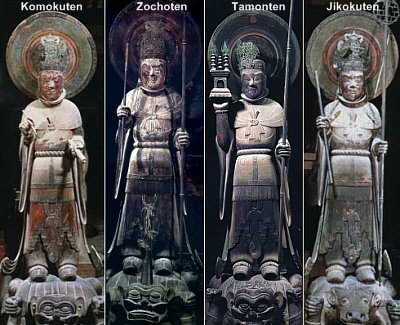
Four Shitennō, Hōryūji Temple 法隆寺, Nara
Mid-7th Century. Oldest extant set of the four.
Kōmokuten 広目天, Zōchōten 増長天, Tamonten 多門天, Jikokuten 持国天
Painted Wood, Each Statue Approx. 133.5 cm in Height
Photos from Comprehensive Dictionary of Japan's Nat’l Treasures
国宝大事典 (西川 杏太郎. ISBN 4-06-187822-0.

JYAKI (JAKI) DEMON - 邪鬼
In Japan, the Four Shitennō Guardians are almost always shown stepping on evil demons called Jyaki or Tentōki. This iconography symbolizes the power of the Shitennō to repel and defeat evil. Click here to learn more about these demons.
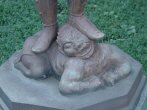 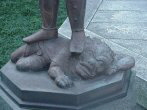 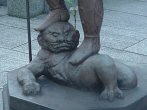
Jyaki at Hase Dera in Kamakura.
Click here for more details about the Jyaki demons.
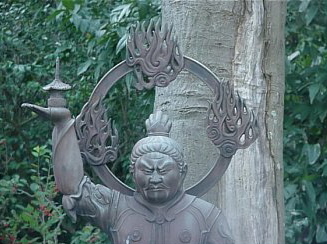
Tamonten at Hase Dera in Kamakura (click to enlarge)

LEARN MORE
- Tamonten is also known as Bishamonten, one of Japan’s Seven Lucky Gods. See the Bishamonten page for more details and more photos.
- Buddhist-Artwork.com, our sister estore, offers statues of the Shitennō.
- Shitennō, Four Heavenly Kings. Four Deva Kings. Guardians of East, West, North, South (the four cardinal directions). The Shitennō are also associated with four legendary creatures of Chinese mythology (dragon, red bird, tiger, turtle). See Shijin (Four Celestial Emblems) for more on these four creatures.
- In the Japanese Mandala, the Shitennō (Guardians of the Four Directions) are typically shown, from the top, starting with the eastern guardian. Thus, the typical order is Jikokuten (East), Zōchōten (South), Kōmokuten (West), and Tamonten (North).
- 28 Constellations, 28 Moon Lodges, 28 Moon Stations (this site)
Learn more about each of the four quarters (north, south, east, west) and the seven constellations in each group. All 28 represent points in the moon’s monthly path, and each was deified.
- Butsuzō-zu-i 仏像図彙, the “Collected Illustrations of Buddhist Images.” Published in 1690. One of Japan’s first major studies of Buddhist iconography. Hundreds of pages and drawings, with deities classified into approximately 80 (eighty) categories. Modern-day reprints of the expanded Meiji-era version are available at this online store (J-site).
- Mandara Zuten 曼荼羅図典 (Japanese Edition). The Mandala Dictionary. 422 pages. First published in 1993. Publisher Daihorinkaku 大法輪閣. Language Japanese. ISBN-10: 480461102-9. Available at Amazon.
- JAANUS. Japanese Architecture & Art Net Users System. Compiled by the late Dr. Mary Neighbour Parent; covers both Buddhist and Shintō deities in great detail and contains over 8,000 entries.
- A Dictionary of Chinese Buddhist Terms. With Sanskrit & English Equivalents. Plus Sanskrit-Pali Index. By William Edward Soothill & Lewis Hodous. Hardcover, 530 pages. Published by Munshirm Manoharlal. Reprinted March 31, 2005. ISBN 8121511453.
- Digital Dictionary of Chinese Buddhism (C. Muller; login "guest")
- Buddhism: Flammarion Iconographic Guides, by Louis Frederic, Printed in France, ISBN 2-08013-558-9, First published 1995.
- 4 Heavenly Kings, Great Mandala Study Group (outside link). Also see Four Heavenly Kings, Nichiren Tradition (outside link). “They appear in the ceremony of the Lotus Sutra with their 10,000 retainer gods in the Dharani (26th chapter). Therein, Jikokuten and Bishamonten pledge on behalf of all four to protect those who embrace the Lotus Sutra.
- Four Heavenly Kings (J-site, outside link), plus Sanskrit characters used herein.
- See Bibliography for our complete list of resources on Japanese Buddhism.

|
|